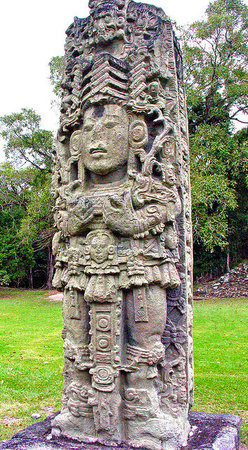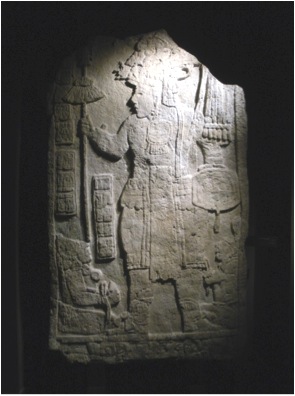Maya Stelae Are Relief Carvings That Usually Represented
Chakalte Relief with Enthroned Ruler lintel from La Pasadita Guatemala Maya late 8th century limestone and paint 889 x 876 x 7 cm 19792061047 The Metropolitan Museum of Art Speakers. He also wears a collar with three images of human.

Classic Maya Portrait Stelae Article Khan Academy
Ancient Maya art is the visual arts of the Mayan civilization an eastern and south-eastern Mesoamerican culture made up of a great number of small kingdoms in present-day Mexico Guatemala Belize and Honduras.
. In Classic Maya society the stela was an important medium through which historical information was conveyed. Stelae are free-standing stone slabs carved in low relief that usually depict portraits of rulers which are accompanied by hieroglyphic texts recording the. James Doyle Assistant Curator for the Art of the Americas The Metropolitan Museum of Art and Dr.
These may be inscribed carved in relief or painted. This wonderful relief centers on. The predominantly monumental art of the ancient Maya civilization in Classic times from the third to the tenth century AD produced close to a thousand known stelae.
The most vital and imposing format was the stela an upright flat slab of stone worked in relief on one two or four faces. Detailed of the polychromed bas-relief in the Palenque museum Chiapas Mexico that depicts Upakal Kinich. Their placement at the base of immense pyramids or in open plazas facing small stage-like platforms suggests that they were intended to be viewed by vast audiences in conjunction with other public spectacles.
A thin planar relief implies spatial dimensions and when the relief is too shallow to allow planar distinction as in the foremost planes of the image. The central figure is most likely a Maya ruler and he wears an enormous tiered headdress with feathers splaying to the tops and sides of the column. This limestone column carved in medium relief depicts an ornately dressed individual and a dwarf.
This carved limestone slab was a wall panel from a Maya palace or administrative structure. This civilization took shape in the. Stelae are free-standing stone slabs carved in low relief that usually depict portraits of rulers which are accompanied by hieroglyphic texts recording the rulers identity and actions.
Artists in first-millennium Maya royal courts created enduring life-sized portraits of their patrons on freestanding stone monuments known as stelae. Stela 31 is complex visually equivocal and perceptively executed. In Classic Maya society the stela was an important medium through which historical information was conveyed.
They were placed where the people could see them. Maya rulers commissioned stone monuments to glorify their ancestry and to proclaim their wealth taste military victories and spiritual power. Stelae were created for many reasons.
It took time and effort to carve a story in rock so only really important stories were told on a stela. The most important sculptural type was the freestanding limestone stela with basrelief carving on one or both of its broad faces usually depicting a single standing human figure now recognizable as a. The large carved stone sarcophagus lid found at the tomb of Pakal the Great in the Temple of Inscriptions.
Each told a story. A Maya stela is a huge stone slab with Maya glyphs and drawings on it. Some historians refer to these ancient stone structures as stone trees.
These monolithic upright stone slabs usually bearing hieroglyphic inscriptions and figures of personages plus the bas-relief tablets in the temples are the carvings from which I have been taking the rubbings now. The Throne 1 of Piedras Negras now in the National Museum of Anthropology and History Guatemala. Such majestic images of powerful kings and queens who ruled over city-states in what is now southern Mexico Guatemala Belize Honduras and El Salvador also contain hieroglyphic texts.
1950 detailed important changes in Maya sculptural traditions from the Late Preclassic through the Classic periods. A stele ˈ s t iː l i STEE-lee or occasionally stela plural stelas or stelæ when derived from Latin is a stone or wooden slab generally taller than it is wide erected in the ancient world as a monumentThe surface of the stele often has text ornamentation or both. Many regional artistic traditions existed side by side usually coinciding with the changing boundaries of Maya polities.
The carving style employed on Stela 31 is as complex as its iconography.

Stela 21 Detail Late Classic Photo By Linda Schele Mayan Cullture Mayan Art Maya Art Ancient Mayan

Pin On Armenian Illuminated Manuscripts

Museum Bulletin Sculptured Monuments From Caracol British Honduras

3 837 Ancient Mesoamerica Photos Free Royalty Free Stock Photos From Dreamstime

Stela The Art Institute Of Chicago

Maya De Palenque Mayan Art Maya Art Ancient Maya

Quirigua The Maya Creation Stones Uncovered History Mayan Art Mayan Cities Mayan

Stela With A Ruler Guatemala Peten Region El Peru Maya Culture Late Cl Mayan Art Cleveland Museum Of Art Maya Art
Column Costumed Figure Maya The Metropolitan Museum Of Art

Stela A Another Portrait Of Cauac Sky Stands Near The Entrance Of Quirigua It Was Erected In 775 Ad And Dedicated Mayan Culture Ancient Aliens Ancient Maya

Chichenitza Bob Chichenitzabob Ancient Maya Ancient Mayan Mayan Cities

Mayan Stelae Tikal Tikal Maya Architecture Ancient Civilizations

Classic Maya Portrait Stelae Article Khan Academy

Classic Maya Portrait Stelae Article Khan Academy

Stela 14 Unlocking The Maya Script Popular Archeology

Jaguar A Symbol Of Strength Divinity And General Domain Over All Things A Very Big Sign Of Power For The Mayans By Nigh Mayan Tattoos Maya Art Mayan Art

The Met S Great Hall To Display Ancient Maya Stone Monuments From Republic Of Guatemala Gothamtogo


Comments
Post a Comment